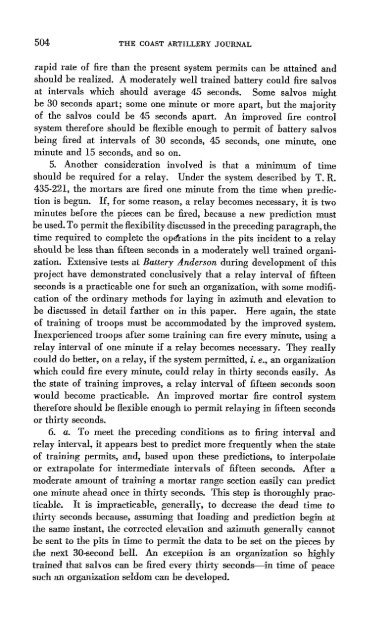COAST ARTILLERY, JOURNAL - Air Defense Artillery
COAST ARTILLERY, JOURNAL - Air Defense Artillery
COAST ARTILLERY, JOURNAL - Air Defense Artillery
Create successful ePaper yourself
Turn your PDF publications into a flip-book with our unique Google optimized e-Paper software.
504 THE <strong>COAST</strong> <strong>ARTILLERY</strong> <strong>JOURNAL</strong><br />
rapid rate of fire than the present system permits can be attained and<br />
should be realized. A moderately well trained battery could fire salvos<br />
at intervals which should average 45 seconds. Some salvos might<br />
be 30 seconds apart; some one minute or more apart, but the majority<br />
of the salvos could be 45 seconds apart. An improved fire control<br />
system therefore should be flexible enough to permit of battery salvos<br />
being fired at intervals of 30 seconds, 45 seconds, one minute, one<br />
minute and 15 seconds, and so on.<br />
5. Another consideration involved is that a minimum of time<br />
should be required for a relay. Under the system described by T. R.<br />
435-221, the mortars are fired one minute from the time when prediction<br />
is begun. If, for some reason, a relay becomes necessary, it is two<br />
minutes before the pieces can be fired, because a new prediction must<br />
be used.To permit the flexibility discussed in the preceding paragraph, the<br />
time required to complete the ope'rations in the pits incident to a relay<br />
should be less than fifteen seconds in a moderately well trained organization.<br />
Extensive tests at Battery Anderson during development of this<br />
project have demonstrated conclusively that a relay interval of fifteen<br />
seconds is a practicable one for such an organization, with some modification<br />
of the ordinary methods for laying in azimuth and elevation to<br />
be discussed in detail farther on in this paper. Here again, the state<br />
of training of troops must be accommodated by the improved system.<br />
Inexperienced troops after some training can fire every minute, using a<br />
relay interval of one minute if a relay becomes necessary. They really<br />
could do better, on a relay, if the system permitted, i. e., an organization<br />
which could fire every minute, could relay in thirty seconds easily. As<br />
the state of training improves, a relay interval of fifteen seconds soon<br />
would become practicable. An improved mortar fire control system<br />
therefore should be flexible enough to permit relaying in fifteen seconds<br />
or thirty seconds.<br />
6. a. To meet the preceding conditions as to firing interval and<br />
relay interval, it appears best to predict more frequently when the state<br />
of training permits, and, based upon these predictions, to interpolate<br />
or extrapolate for intermediate intervals of fifteen seconds. Mter a<br />
moderate amount of training a mortar range section easily can predict<br />
one minute ahead once in thirty seconds. This step is thoroughly practicable.<br />
It is impracticable, generally, to decrease the dead time to<br />
thirty seconds because, assuming that loading and prediction begin at<br />
the same instant, the corrected elevation and azimuth generally cannot<br />
be sent to the pits in time to permit the data to be set on the pieces hy<br />
the next 30-second bell. An exception is an organization so highly<br />
trained that salvos can be fired every thirty seconds-in time of peace<br />
such an organization seldom can be developed.
















